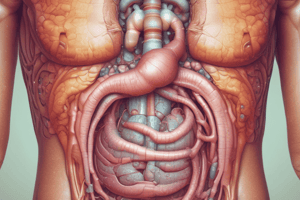Podcast
Questions and Answers
What are the subtypes of functional constipation?
What are the subtypes of functional constipation?
The subtypes of functional constipation are slow transit, normal transit, and dyssynergic defecation.
How is slow-transit constipation defined?
How is slow-transit constipation defined?
Slow-transit constipation is defined as the delayed passage of fecal contents through the colon based on objective transit testing.
What is dyssynergic defecation?
What is dyssynergic defecation?
Dyssynergic defecation refers to difficulty with or inability to expel stool due to abnormalities in contraction and/or relaxation of the muscles of the pelvic floor during defecation.
Why is it recommended for all patients with PSC without known IBD to have colonoscopy with biopsies at the time of PSC diagnosis?
Why is it recommended for all patients with PSC without known IBD to have colonoscopy with biopsies at the time of PSC diagnosis?
What are the common colonoscopy findings in patients with PSC and IBD?
What are the common colonoscopy findings in patients with PSC and IBD?
Why is surveillance colonoscopy with biopsies recommended every 1 to 2 years for patients with PSC and IBD?
Why is surveillance colonoscopy with biopsies recommended every 1 to 2 years for patients with PSC and IBD?
What is the recommended surveillance for cholangiocarcinoma in patients with PSC?
What is the recommended surveillance for cholangiocarcinoma in patients with PSC?
What is the lifetime risk for cholangiocarcinoma in patients with PSC?
What is the lifetime risk for cholangiocarcinoma in patients with PSC?
What diagnostic tests are recommended for cholangiocarcinoma surveillance in patients with PSC?
What diagnostic tests are recommended for cholangiocarcinoma surveillance in patients with PSC?
What are the three criteria required for the diagnosis of acute pancreatitis?
What are the three criteria required for the diagnosis of acute pancreatitis?
How much should the serum lipase or amylase levels be elevated for the diagnosis of acute pancreatitis?
How much should the serum lipase or amylase levels be elevated for the diagnosis of acute pancreatitis?
What is the characteristic imaging finding required for the diagnosis of acute pancreatitis?
What is the characteristic imaging finding required for the diagnosis of acute pancreatitis?
Who should be screened for Barrett esophagus according to the given criteria?
Who should be screened for Barrett esophagus according to the given criteria?
What are the risk factors that warrant screening for Barrett esophagus?
What are the risk factors that warrant screening for Barrett esophagus?
For how long should individuals with gastroesophageal reflux disease symptoms be experiencing the symptoms to warrant screening for Barrett esophagus?
For how long should individuals with gastroesophageal reflux disease symptoms be experiencing the symptoms to warrant screening for Barrett esophagus?
What is the recommended initial therapy for patients with ulcerative proctitis?
What is the recommended initial therapy for patients with ulcerative proctitis?
What type of 5-ASA therapy is superior for inducing remission in patients with left-sided or extensive ulcerative colitis?
What type of 5-ASA therapy is superior for inducing remission in patients with left-sided or extensive ulcerative colitis?
What is the role of 5-aminosalicylates in maintaining remission in ulcerative proctitis?
What is the role of 5-aminosalicylates in maintaining remission in ulcerative proctitis?
Flashcards are hidden until you start studying




